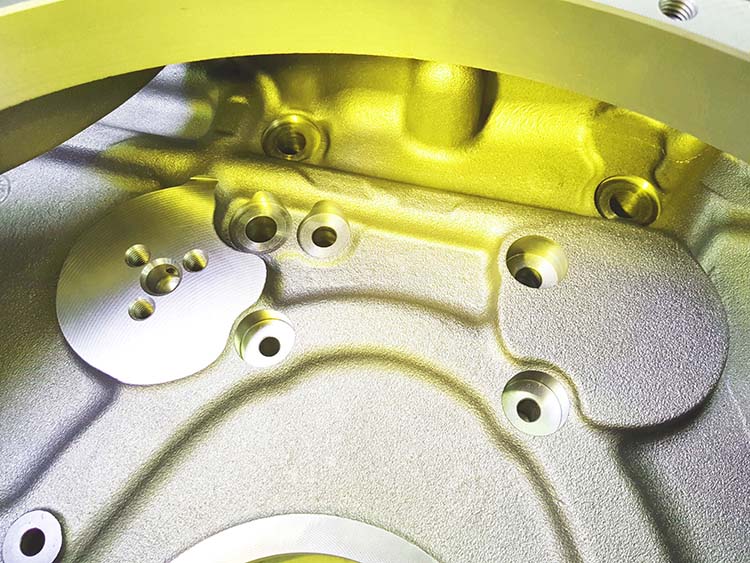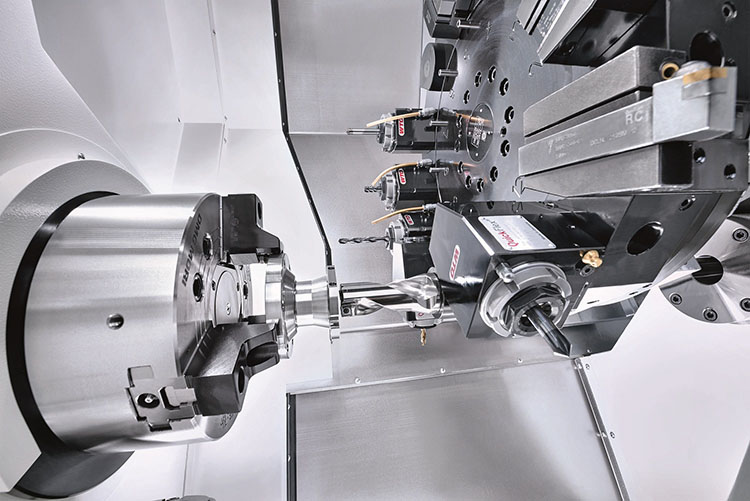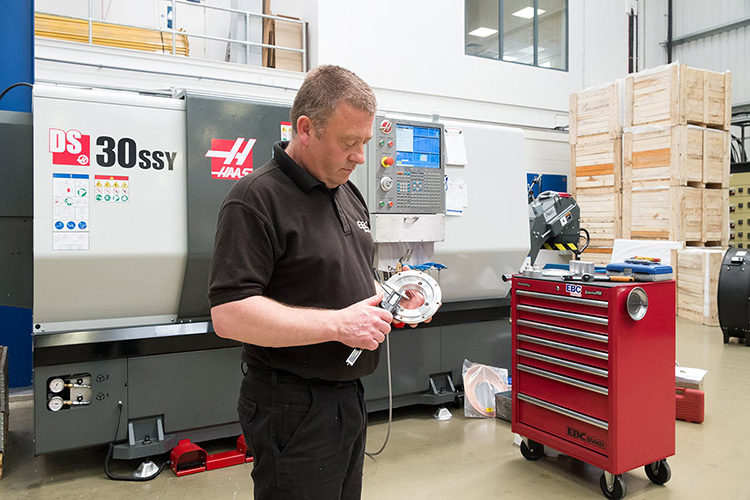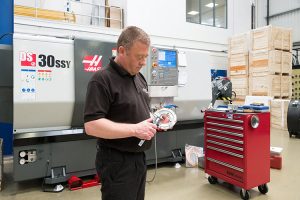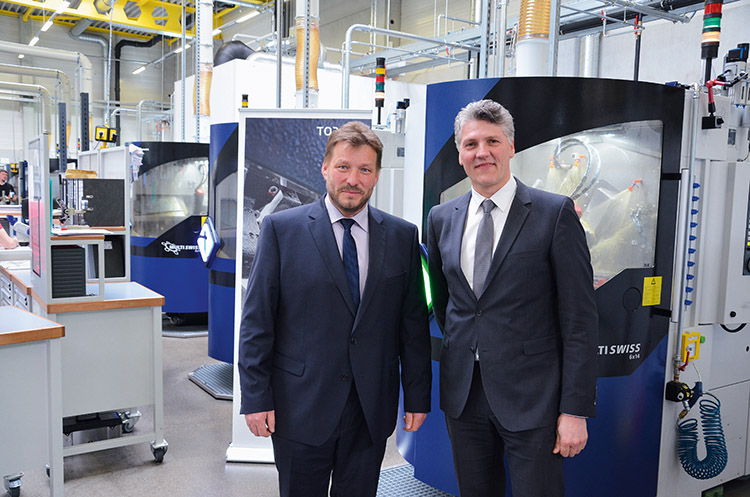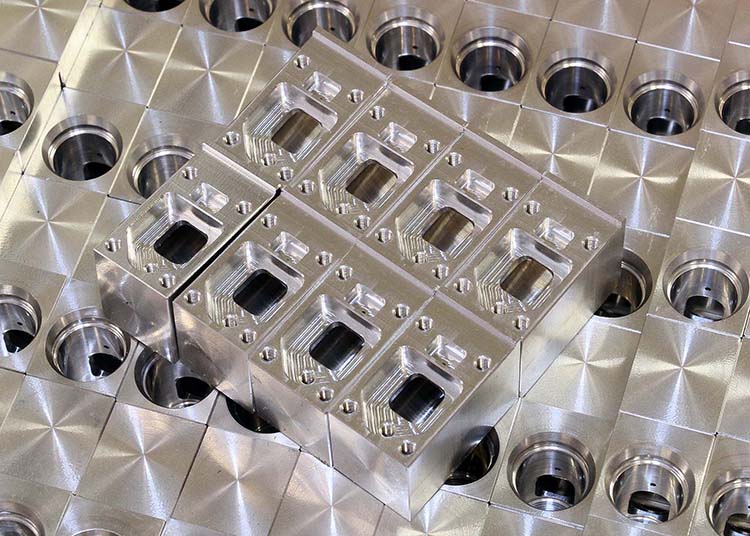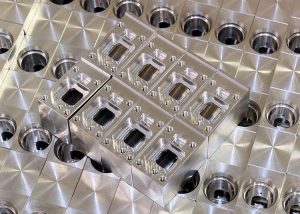By calling in Mollart Engineering’s tooling specialist, a move that led to the introduction of a Steiner Autofacer back-counterboring tool, Atherstone-based precision subcontractor Lunn Engineering has been able to introduce a fully automatic production cycle, significantly reducing production lead-time and operational routines when machining cast iron flywheel housings for off-road vehicles. Previously, due to access difficulties and the design restraints of certain features, a separate counterboring operation had to be set up in an adjacent machining bay that not only introduced logistical problems and additional work-handling, but also significantly extended lead-times.

“We have produced some 1400 of these components on our horizontal, twin-pallet machining centre, which was installed specifically to manufacture these castings,” says works foreman Martin Sharpe. “However, we have always had to run an additional operation on a horizontal borer located in another bay just to produce three counterbore features that were very difficult to access as they were set back behind the main location flange of the housing.”
He follows on to explain that the effect of combining operations from three into two has been relatively marginal on overall cycle time, but importantly it has enabled a fully automatic production cycle involving A and B fixtures on the twin-pallet machine that has considerably reduced lead times, work handling, setting, operator attendance and inspection times. As a result of the change, Lunn Engineering has also been able to concentrate production and sub-assembly of the flywheel housing in one area of the works.

Sharpe adds how the customer has gained from improved control over quality by eliminating a third relocation of the workpiece, while tool life has been increased to achieve some 120 counterbores per insert corner. This improved performance is largely due to the combination of the inherent rigidity of the machining centre and the Autofacer tool set-up, as opposed to the previous method with varying tool life and the workholding arrangement of the borer.
Lunn Engineering produces two types of housing for two- and four-wheel drive off-road vehicles at a rate of 15 per week. Following machining, the housings are cleaned, painted and then sub-assembled for the customer, which includes the insertion of bearings. The revised fully automatic machining sequence, following Mollart’s change to the application, now involves just two operations on the machining centre that incorporate considerable milling, boring, drilling, counterboring and tapping sequences.
Following the approach by Sharpe, Mollart’s tooling specialist came on site to assess the operation. He found that with access to produce the three counterbores being severely restricted, the objective could only be achieved by back counterboring through three 18 mm diameter holes. These holes are drilled through from the outer face of the housing directly opposite the main flange face that is used for initial first operation location on the fixture. It was this main flange that partially covered each counterbore position.
Adding to the problems was a steep draft angle around each of the three features which meant any back counterboring tool had to cope with progressive material build-up, creating a variable interrupted cut. Indeed, this draft angle aided the failure of previous attempts to back-counterbore using competitor tooling, resulting in chatter and inconsistent tool life.
According to Sharpe, following the visit and assessment by Mollart’s tooling engineer, it was recommended that the Steiner Autofacer tool be employed because of its high rigidity and being well-proven in applications of this type. Both Sharpe and the engineer then worked together to develop the process and set the speeds and feed rates whereby the spindle is now run at 810 rpm at a feed rate of 0.04 mm/rev.
The Steiner ‘bump style’ Autofacer spotface/counterbore tool is activated from contact with the datum face of the workpiece as it passes through the previously drilled 18 mm holes. Each drilled hole is used to support a pilot bearing on the Autofacer tool that is positioned behind the insert pocket on the body of the tool. By reversing the machine spindle, an internal friction clutch mechanically opens and locks the cutter blade to the set dimension of 36 mm diameter.
The tool is then fed in reverse back into the casting, and when a programmed depth of 32.5 ±0.05 mm is reached from the machined datum face, is fed back before a cone positively drives the cutter blade to its closed position into the tool head. It now takes just 6 minutes and 20 seconds to complete the three holes.
Lunn Engineering was originally formed as a general engineering and subcontract business in 1938 under the name of the Rotary Pump Company. In 1952, the firm changed to Lunn Engineering Co, when it became a principal supplier to the UK’s very active, at that time, machine tool sector. During 1960, the company moved to its current 16,000 sq ft site in Atherstone, producing five-speed gearboxes for the mining industry and safety clutches for conveyor systems.
In 1969 the company obtained manufacturing rights for Lunn Davis keyseater machines, which the company updated two years ago to include its own design of control system. Since commencing production, Lunn Engineering has built over 200 machines with demand now increasing following the introduction of the new control.
Lunn also specialises in design, development and prototyping for customers and employs 22 people. The company designs, builds and re-engineers equipment such as special rotary table chucks used in ultrasonic testing, and produces test rigs and fixtures for leak testing products such as domestic showers. In addition to its design and build operations, Lunn’s subcontract production supplies sectors such as metrology, machine tool, off-road and specialist aerospace and automotive related industries with batches of work that vary between 40 and 300 parts. Over 70% of the order book is repeat business.
Says owner and managing director Fred Lunn: “We had such a recent success producing a one-off bespoke gold-plated desk fitted with an Onyx top for one of our customers – a leading UK aircraft interior specialist – that we were then asked to make a smaller version to accommodate a printer.”
Following the success of the application engineering and trials of the Mollart-supplied Autofacer, the engineering team is now working on further process improvements to replace twist drills used on specific deep holes in the two housing types with Botek gun-drills. This strategy will provide improved efficiently to produce certain special holes within ±0.2 mm geometrical tolerances.
For further information www.mollart.com






